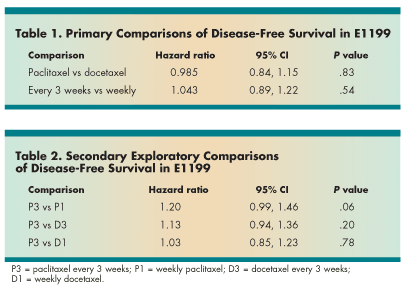Taxanes Comparable as Adjuvant Therapy of Breast Cancer; Weekly Paclitaxel More Effective Than q3wk
Docetaxel (Taxotere) and paclitaxel (Taxol) produced similar outcomes in the adjuvant treatment of breast cancer in the North American Breast Cancer Intergroup Trial E1199. Joseph Sparano, MD, profesor of medicine, Albert Einstein Cancer Center, Montefiore Medical Center, New York, presented the results as a late-breaking abstract at the 28th Annual San Antonio Breast Cancer Symposium (abstract 48).
SAN ANTONIODocetaxel (Taxotere) and paclitaxel (Taxol) produced similar outcomes in the adjuvant treatment of breast cancer in the North American Breast Cancer Intergroup Trial E1199. Joseph Sparano, MD, profesor of medicine, Albert Einstein Cancer Center, Montefiore Medical Center, New York, presented the results as a late-breaking abstract at the 28th Annual San Antonio Breast Cancer Symposium (abstract 48). Dr. Sparano presented the fourth interim analysis of the 4,998-woman study of node-positive (T1-3, N1-2) or high-risk node-negative (T2-3, N0) breast cancer patients. The trial used a 2 X 2 factorial design, with the primary comparisons evaluating taxane type (paclitaxel vs docetaxel) and schedule (every 3 week vs weekly).
Both taxanes bind to a specific pocket of beta tubulin and prevent depolymerization of microtubules, Dr. Sparano said, but docetaxel binds more avidly to beta tubulin, which contributes to more potent cell cycle, apoptotic, and antiangiogenic effects observed in preclinical systems for docetaxel. There have also been a number of phase II and III trials in metastatic disease suggesting greater efficacy for docetaxel compared with paclitaxel when given every 3 weeks, and for weekly paclitaxel compared with paclitaxel given every 3 weeks, he said.
Prior to receiving the taxane, patients were given four cycles of doxorubicin 60 mg/m2 plus cyclophosphamide 600 mg/m2 (AC) every 3 weeks, then randomized to docetaxel or paclitaxel weekly (D1, P1) for up to 12 doses, or every 3 weeks (D3, P3) for up to 4 doses. Dosages were as follows: P3 175 mg/m2; P1 80 mg/m2; D3 100 mg/m2; D1 35 mg/m2). Patients with positive hormonal status took tamoxifen (amended to include aromatase inhibitors) for 5 years after completion of therapy. The fourth interim analysis occurred at a median follow-up of 46.5 months, after 856 disease-free survival events and 483 deaths.
"There were no significant differences in the primary comparisons of disease-free survival, by either taxane or schedule," Dr. Sparano reported (see Table 1), "and it is unlikely that either comparison could become significant after full planned information is obtained."

In an unplanned analysis of relapse, he said, "There were about 15% fewer relapses in the P1 and D3 arms, compared with the P3 arm." In secondary exploratory analyses comparing the standard P3 arm vs the other arms, there was a trend favoring the weekly paclitaxel arm vs the every-3-week arm (hazard ratio 1.20; P = .06). The other comparisons demonstrated no differences for the D1 arms (see Table 2).
When comparing the P3 vs P1 arms by estrogen receptor (ER) and/or progesterone receptor (PR) expression status, there was a trend for greater benefit for weekly paclitaxel in ER/PR-negative disease (HR 1.30; P = .07), compared with ER- and/or PR-positive disease (HR 1.15; P = NS).
The projected 5-year disease-free survival for the P3 arm was 73%. In comparison, the 4-year disease-free survival rates were 80.6% for P3, 83.5% for P1, 83.1% for D3, and 80.5% for D1. For overall survival, the projected 5-year rate for P3 was 81%, while the 4-year observed survival rates were 88.8%, 91.7%, 89.3%, and 88.9%, for P3, P1, D3, and D1, respectively, he reported.
The most common grade 3-4 toxicity for the taxane component (5% or more) differed according to treatment arm. In particular, D3 had considerably more neutropenia (46%) compared to all the other arms in the study (less than 5%), resulting in more febrile neutropenia (16% vs less than 1%) and infection (13% vs less than 5%). Fatigue and stomatitis also occurred more commonly in the docetaxel arms, while neuropathy was more likely with paclitaxel (although less than 10%).
"Which taxane and which taxane schedule are most effective has been a question for many years," Dr. Sparano said. "Physicians and patients may now make more informed decisions about selecting one of several adjuvant taxane-containing regimens. Sequential administration of an anthracycline/alkylator couplet followed by weekly paclitaxel may now be considered a reasonable treatment option."
Newsletter
Stay up to date on recent advances in the multidisciplinary approach to cancer.